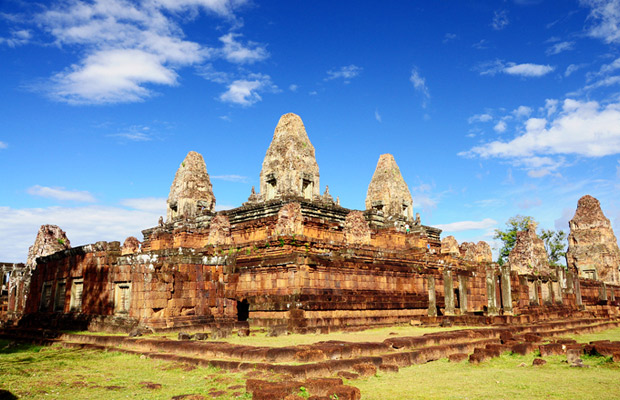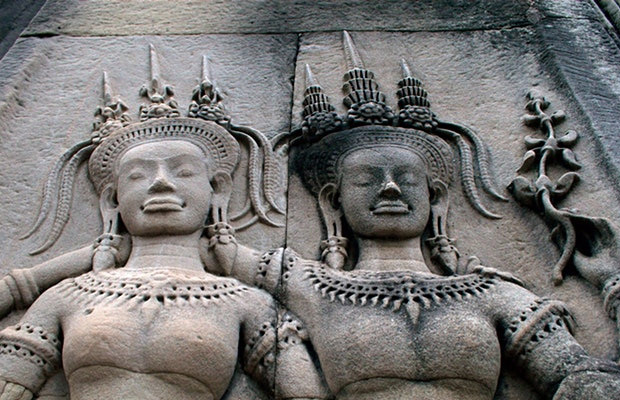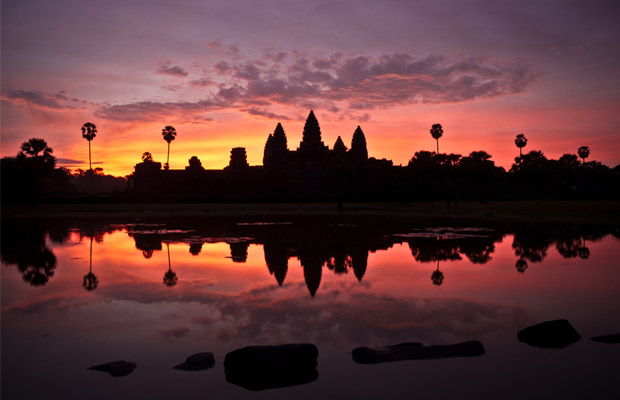Banteay Kdei Temple
Extensive monastic complex, largely unrefurbished, in the same style as Ta Prohm. It was originally built on the site of an earlier temple, and functioned as a Buddhist monastery under Jayavarman VII. As with other works of the Jayavarman VII era, it is a well-packaged architectural mess, which, like Bayon, underwent several changes in plans at the time of construction. It was also built using a lower sandstone grid and using poor construction techniques, leading to much of the deterioration visible today.
Overview of Banteay Kdei Temple
Banteay Kdei (Khmer: ប្រាសាទបន្ទាយ ក្តី; Prasat Banteay Kdei), meaning "The Citadel of Chambers", also known as "Citadel of Monks" cells, is a Buddhist temple in Angkor, Cambodia, located southeast of Ta Prohm and east of Angkor Thom. Built in the mid-12th century until the early 13th century during the reign of Jayavarman VII (which was postually given the title "Maha paramasangata pada"), it is in the Bayon architectural style, similar to the plan for Ta Prohm, and Preah Khan, but less complex and smaller. Its structures are contained in two successive siege walls, and consist of two concentric galleries from which towers emerge, preceded to the east by a cloister.
This Buddhist monastic complex is currently in ruins because of the defective and low quality construction of sandstone used in its buildings, and is now under renovation. Banteay Kdei had been occupied by monks at various intervals throughout the centuries until the 1960s.
Geography of the Banteay Kdei Temple
Banteay Kdei, one of the many temples of Angkor, is located in the 400-square-kilometer (150-square-mile) Angkor Archaeological Park. The ancient city of Angkor during the Khmer Empire stretched from Tonle Sap to the Kulen Hills covering a vast area of 1,000 square kilometers (390 square miles). [5] The temple is approached from the east gopura of Ta Prohm along a path of 600 meters (2,000 feet). This path leads to the entrance gopura from the west gate of Banteay Kdei. It is 3 km (3 km) east of Angkor Thom.
History of the Banteay Kdei Temple
The name of Banteay Kdei comes from an earlier name, Kuti, which is mentioned in Sdok Kak Thom. This wake describes the arrival of Jayavarman II to the area: "When they arrived in the eastern district, the king granted a property and a village called Kuti on the family of the royal chaplain." This royal chaplain was the scholar of Brahman Sivakaivalya, his chief priest for the cult of Devaraja.
The Khmer Empire lasted from 802 to 1431, initially under Hindu religious beliefs until the end of the 12th century and later under Buddhist religious practices. It was a time when the temples of greatness were built and reached a crescendo during the reign of Suryavarman II until 1191, and later in the XII-XIII centuries, under Jayavarman VII. Many Buddhist temples were built, including the Banteay Kdei, from the middle of the 12th century to the beginning of the 13th century. Although Jayavarman VII was credited with building many temples, he was also accused of wasting money on extravagant temple construction projects at society and other duties. He built Buddhist temples in which Bodhisattva Avalokitesvara was the chief deity. This temple built, conforming to the temples style of Ta Prohm and Preah Khan in the vicinity during the same period by Jayavarman VII, but of smaller size, was built as a Buddhist monastic complex on the site of a 10th century temple built by Rajendravarman . Some small inscriptions attest to the construction of this temple by Jayavarman VII and the royal architect, Kavindrarimathana.
Jayavarman VII came to power at age 55 after defeating Chams who invaded Angkor and subjected him to devastation. His "prodigious activity" resulted in the restoration of Cambodia from its ruins. He was primarily the architect of the reconstructed capital at Angkor Thom and was called the "Great Builder". He was responsible for building many temples, which, in addition to Banteay Kdei, included the central temple of Bayon, Prah Khan, Ta Prohm and many others, as well as many rest homes for pilgrims. The reasons for building this temple on your current site are not known. However, it is established that the temple is a contemporary of Angkor Wat, since many similarities have been identified between the two, and also with the Phimai temple in Thailand. It is reported to be the first temple built by Jayavarman VII in 1181 AD, opposite the Srah Srang reservoir.
In the 13th century, most of the temples built by Jayavarman were vandalized. However, some of the Mahayana Buddhist pediments and lintels are still seen in good condition. It is also the view of some archaeologists that the temple was built by Jayavarman II in honor of his religious teacher.
The temple, which for several centuries after the Khmer's reign ended, remained neglected and covered with vegetation. It was exposed after clearing excessive vegetation growth in 1920-1922. This work was conducted under the guidance of Henri Marchal (then Conservative of Angkor) and Ch. Battuer, adopting a conservation principle which was known as "the principle of anasthylosis, which was being used very effectively by the Dutch authorities in Indonesia." It was partially occupied by Buddhist monks until the 1960s.
For ten years until March 2002, the University Mission
View Mores Temple Guide

Bat Chum
Bat Chum (Khmer: ប្រាសាទបាទជុំ) is a small temple built by Kavindrarimathana, a scholarly Buddhist minister of the Khmer king Rajendravarman [1]: 116 in the middle of the ...

Terrace of the Leper King
Leper King Terrace (Khmer: ព្រះ លាន ស្តេ ច គម្លង់, Preah Learn Sdech Kunlung) is located in the north-west corner of the Royal Square of Angkor Thom in Cambodia. ...

Preah Khan Temple
Preah Khan Temple is located 2 km northeast of Angkor Thorn on the Grand Circuit. The temple was built in the second half of the 12th century AD in AD 1191 by King Jaya-varman VII, dedicating to his ...

Banteay Thom
Banteay Thom is a lovely temple where the main appeal is its rural setting; It is only reached by sandy trails through rice and bush, where you are likely to seek a farmer, a buggy or anyone on the ...

Baksei Chamkrong
Baksei Chamkrong is a small Hindu temple situated in the Angkor complex (Siem Reap, Cambodia). He is dedicated to Lord Shiva and used to keep a golden image of him. The temple can be seen on the left ...

Pre Rup Temple
Pre Rup (Khmer: ប្រាសាទប្រែរូប) is a Hindu temple in Angkor, Cambodia, built as the state temple of King Khmer Rajendravarman [1]: 116 [2]: 73-74 [3]: 361-364 and ...

Banteay Samre Temple
Banteay Samre is one of the most complete complexes in Angkor due to restoration using the anasthylosis method. Unfortunately, the lack of maintenance in the last 20 years is ...

West Baray
The West Baray (Khmer: បារាយណ៍ទឹកថ្លា, Baray Teuk Thla) is a baron or reservoir, in Angkor, Cambodia, oriented to the east and west, located west of the walled city, ...

Preah Vihear Temple
Preah Vihear Temple (Khmer: ប្រាសាទព្រះវិហារ Prasat Preah Vihea) is an ancient Hindu temple built during the period of the Khmer Empire, which sits atop a 525-meter ...

Angkor Thom West Gate
The sidewalk at the west gate of Angkor Thom collapsed completely, leaving a heap of ancient stones coming out of the ground like victims of a terrible historical ...

Wat Bo Pagoda
Wat Bo Pagoda, near the Siem Reap River on the east side, is one of the oldest in Siem Reap and a peaceful place to escape and take a break to visit the main sites of the nearby Angkor ...

Prasat Prei
Small temple ruins unite in a forest setting near Neak Pean. Remains of a gopura, the central tower and halls, and the vestiges of a library and surrounding wall. Some apsara and lintel sculptures. A ...












